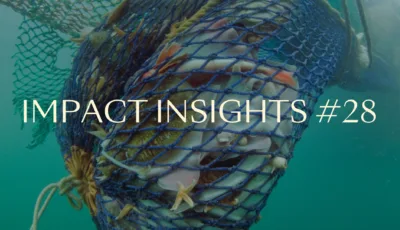Impact Insights #17

Norselab’s Impact Analyst, Oda Standal, has compiled the most recent impactful insights that are shaping the field of sustainability.
■ OECD reports: Unexpected increase in climate finance for developing countries - investments exceed annual $100 billion goal
New OECD figures show that climate finance for developing countries increased by 30% from 2021 to 2022. Developed countries mobilized USD 115,9 billion in climate financing for developing countries, exceeding - for the first time - the annual 100 billion goal set for 2025. This is good news for the climate agenda although the goal was reached two years after the initial target date in 2020. The financing includes both public and private capital, with multilateral public capital, such as from international organizations, constituting the biggest contribution.
This is OECD’s seventh assessment of progress towards the UNFCCC goals agreed upon in 2009 to mobilize 100 billion a year to help developing countries mitigate and adapt to climate change. OECD secretary-general Mathias Cormann commented: “It will be important to sustain this level of elevated support through 2025 while also increasing our ambition for the new post-2025 goal. Multilateral providers and the private sector will be key to further bridging the investment gap, notably in areas such as clean energy, agriculture, and resilience”.
■ European Council adopts landmark nature restoration regulation to restore ecosystems by 2050
The European Council has formally adopted a first-of-its-kind regulation on nature restoration. The regulation aims to mitigate climate change and the effects of natural disasters through legally binding targets and obligations for member states to restore land and sea ecosystems, including seagrass and coral beds. Key provisions of the regulation mandate that member states collectively restore at least 20% of the EU's land and sea areas by 2030 and ensure the restoration of all ecosystems in need by 2050.
Notably, the regulation includes measures to protect pollinators, which have seen dramatic declines across Europe in recent decades. It also outlines specific requirements for various ecosystems, such as agricultural lands, forests, and urban environments, to ensure comprehensive and effective restoration efforts.
■ China’s peak in CO2 emissions may already be behind us
An analysis by Carbon Brief suggests that China's CO2 emissions may have peaked in 2023. In March 2024, emissions fell by 3%, driven mainly by reduced coal use, stagnant oil demand, and a 22% drop in cement production due to declining construction activity. Expanded solar and wind activity met 90% of the growth in electricity demand for the same month. These trends are expected to continue as real estate investments are likely to continue declining due to government measures against overreliance on borrowed funds.
Other developments include an increase in the share of electric vehicles on Chinese roads, now accounting for one in ten cars, and reducing petrol demand growth by 3.5 %. However, sustaining emissions reductions will require maintaining the record levels of clean energy development observed last year. Despite strong economic incentives for solar and wind projects, the main constraint on further growth in capacity will be grid access and capacity.
■ Right-Wing surge in EU elections could challenge climate policies
Right-wing parties gained ground in the 2024 European Parliament elections, although less than predicted. Despite significant wins and losses for several parties, no single bloc emerged with an overall majority, prompting centrist parties to form a coalition to support a second term for Ursula von der Leyen. Although right-wing parties face internal disagreements, they are typically united in their resistance to EU-led climate and environmental measures. With increased influence from parties like France's National Rally and Germany's Alternative for Germany, opposition to the EU's ambitious climate targets is mounting. However, the strengthening of red-green coalitions in Nordic countries may help sustain momentum for climate action within the EU. Additionally, as the Fit for 55 package has been officially adopted; reversing policies in the package would be difficult due to the intricate adoption process of European legislation. The Fit for 55 package is a comprehensive EU initiative aimed at reducing greenhouse gas emissions by 55% by 2030, consisting of various laws, regulations, and directives that target areas such as renewable energy, energy efficiency, carbon pricing, and emissions trading.
■ Impact funds start to demonstrate solid returns, attracting investor interest
Early mainstream private equity impact funds demonstrate robust performance amid evolving market dynamics. These funds, aimed at generating positive returns alongside measurable social or environmental impacts, have shown competitive returns relative to traditional private equity funds. This trend highlights a growing investor appetite for impact investing, positioning private equity impact funds as influential players in shaping the future of sustainable finance. Steve Ellis, co-managing partner of TBG, remarked that the data, so far, is “very encouraging” while also noting that “it will take more time for the industry to build a long-term track record. [...] We are still in the early stages of what this market is and what it can be.”


